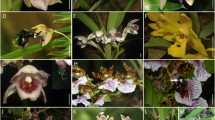Abstract
Floral scent has been suggested to play a key role in the obligate pollination mutualism between yuccas and yucca moths. We analyzed floral fragrance compounds of Yucca elata with headspace collection followed by gas chromatography and mass spectrometry, and compared the odor blend with the recently characterized blend of the allopatric Yucca filamentosa. A principal component analysis based on 20 scent compounds revealed that the floral odor bouquets of Y. elata and Y. filamentosa are virtually identical. Although the two plants belong to the same section of capsular-fruited yuccas, they rely on different species of Tegeticula moths for pollination and probably have been allopatric for several million years. Yet, their floral odor blends are very similar, which may indicate that strong selection by obligate pollinators counteracts drift or divergence in this trait.



Similar content being viewed by others
References
Althoff, D. M., Segraves, K. A., Leebens-Mack, J., and Pellmyr, O. 2006. Patterns of speciation in the yucca moths: parallel species radiations within the Tegeticula yuccasella species complex. Syst. Biol. 55:398–410.
Ayasse, M., Schiestl, F. P., Paulus, H. F., Löfstedt, C, Hansson, B. S., Ibarra, F., and Francke, W. 2000. Evolution of reproductive strategies in the sexually deceptive orchid Ophrys sphegodes: how does flower-specific variation of odor signals influence reproductive success? Evolution 54:1995–2006.
Azuma, H., Toyota, M., and Asakawa, Y. 2001. Intraspecific variation of floral scent chemistry in Magnolia kobus DC. (Magnoliaceae). J. Plant Res. 114:411–422.
Dötterl, S., Wolfe, L. M., and Jürgens, A. 2005. Qualitative and quantitative analyses of flower scent in Silene latifolia. Phytochemistry 66:203–213.
Fenster, C. B. 1991. Selection on floral morphology by hummingbirds. Biotropica 23:98–101.
Graham, A. 1999. Late Cretaceous and Cenozoic History of North American Vegetation North of Mexico. Oxford University Press, New York.
Grison, L., Edwards, A. A., and Hossaert-McKey, M. 1999. Interspecies variation in floral fragrances emitted by tropical Ficus species. Phytochemistry 52:1293–1299.
Grison-Pigé, L., Hossaert-McKey, M., Greff, J. M., and Bessière, J.-M. 2002a. Fig volatile compounds—a first comparative study. Phytochemistry 61:61–71.
Grison-Pigé, L., Bessière, J.-M., and Hossaert-McKey, M. 2002b. Specific attraction of fig-pollinating wasps: role of volatile compounds released by tropical figs. J. Chem. Ecol. 28:283–295.
Hossaert-McKey, M., Gibernau, M., and Frey, J. E. 1994. Chemosensory attraction of fig wasps to substances produced by receptive figs. Entomol. Exp. Appl. 70:185–191.
Knudsen, J. T. 2002. Variation in floral scent composition within and between populations of Geonoma macrostachys (Arecaceae) in the western Amazon. Am. J. Bot. 89:1772–1778.
Mant, J., Peakall, R., and Schiestl, F. P. 2005. Does selection on floral odor promote differentiation among populations and species of the sexually deceptive orchid genus Ophrys? Evolution 59:1449–1463.
McKelvey, S. D. 1947. Yuccas of the Southwestern United States, part 2. Arnold Arboretum, Jamaica Plains, MA, USA.
Pammel, L. H. 1925. The extension of the yucca moth. Science 61:414–415.
Pellmyr, O. 1999. Systematic revision of the yucca moths in the Tegeticula yuccasella complex (Lepidoptera: Prodoxidae) north of Mexico. Syst. Entomol. 24:243–271.
Pellmyr, O. 2003. Yuccas, yucca moths, and coevolution: a review. Ann. Mo. Bot. Gard. 90:35–55.
Powell, J. 1992. Interrelationships of yuccas and yucca moths. Trends Ecol. Evol. 7:10–15.
Powell, J. A. and Mackie, R. A. 1966. Biological Interrelationships of Moths and Yucca whipplei. University of California Publications in Entomology, no. 42. University of California Press, Berkeley.
Riley, C. V. 1872. The fertilization of the yucca plant by Pronuba yuccasella. Can. Entomol. 4:182.
Song, Q., Yang, D., Zhang, G., and Yang, C. 2001. Volatiles from Ficus hispida and their attractiveness to fig wasps. J. Chem. Ecol. 27:1929–1942.
SAS Institute. 1998. JMP 3.2.1. SAS Institute Inc., Cary, NC.
Segraves, K. A. and Pellmyr, O. 2004. Testing the out-of-Florida hypothesis on the origin of cheating in the yucca–yucca moth mutualism. Evolution 58:2266–2279.
Svensson, G. P., Hickman, M. O. Jr., Bartram, S., Boland, W., Pellmyr, O., and Raguso, R. A. 2005. Chemistry and geographic variation of floral scent in Yucca filamentosa (Agavaceae). Am. J. Bot. 92:1624–1631.
Acknowledgements
Permission to collect floral scent was kindly provided by Big Bend National Park. We thank Michael Hickman for providing technical assistance. We also thank Jette Knudsen, Lina Kristoffersen, Wen Qi Rosén, Christian Olsson, Maria Strandh, and two anonymous reviewers who gave valuable comments on the manuscript. This project was supported by a grant from the Wenner–Gren Foundations in Sweden (postdoctoral fellowship) to GPS; NSF grant DEB-0317217 to RAR; and NSF grants DEB-0075944, DEB-0075803, and DEB-0516841 to OP.
Author information
Authors and Affiliations
Corresponding author
Rights and permissions
About this article
Cite this article
Svensson, G.P., Pellmyr, O. & Raguso, R.A. Strong Conservation of Floral Scent Composition in Two Allopatric Yuccas. J Chem Ecol 32, 2657–2665 (2006). https://doi.org/10.1007/s10886-006-9189-6
Published:
Issue Date:
DOI: https://doi.org/10.1007/s10886-006-9189-6




